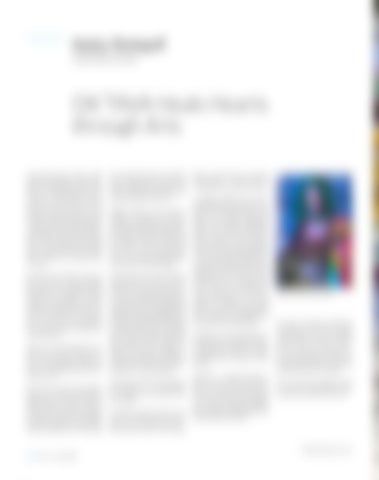Nadya Shelegoff Portland State University
OK’TAVA Heals Hearts through Arts In the gritty reality of Geneva, where deeply rooted traditions meet the harsh modern-world challenges, there’s a place that does not deal in fancy talk or clinical cures. It is called OK’TAVA, an open arts studio. It is not merely a haven for artistic expression. For some, it is a ray of hope in a world drowning in the noise of verbal communication that often fails to bridge the gaps created by displacement, isolation, and the relentless march of time. This is the place where healing doesn’t need words but paints a canvas of solace, a refuge where the brushstrokes speak louder than any therapy session ever could.
does not fit the lock anymore. Especially when a refugee fleeing a war cannot be cured by traditional counseling or even simple soothing words. That’s where the convictions of OK’TAVA kick in.
Let me take you straight to the core of OK’TAVA, where a young Ukrainian girl, a refugee in this foreign land, fought her battles not with words but with the rebellion of her paintbrush. Anorexia and mental storms held her captive, and traditional counseling and even art therapy was seen by her as the enemy. She saw it as a clinical cure, a prescribed fix for a soul that craved the soothing touch of painting instead.
I have seen the power of art, the kind of healing that does not wait for words to catch up. The story of this girl? It is not a rarity. It is but a snapshot of a global reality. Therapy, with the stigma tracing it in so many corners, needs reimagining and rethinking. OK’TAVA is stepping on this path. They call it healing through art, not art therapy. Guided by Vicky TSIAOUSI and invited artists, all those who partake travel around the world in Greek boats made of clay, adorned by Tibetan prayer flags, soothed by Celtic mandalas, invigorated by Australian aboriginal art, cured by candlelit yoga and meditation, replenished by cooking classes and nurtured by music, dance and singing.
I get it. I am a classical pianist who escaped the sorrow and violence in the Soviet Union through the eloquence of music. In the healing space of OK’TAVA, the story of this Ukrainian girl struck a chord in my soul. In my view as a musician with a difficult life story in tow, U4U and OK’TAVA are tearing down the walls of conventional therapy. Their key message is that in a world stormed by the noise of gadgets, torn apart by a pandemic, and fractured by climate change and violent conflicts, verbal communication is a rusty key that
Imagine arriving in a new country, a stranger in a strange land, your pain screaming louder than your words ever could. The young Ukrainian girl felt that. She resisted art therapy, not because she was stubborn, but because therapy felt like medicine. That’s the thing about words – they can be medicinal, sterile, and cold. And simply incomprehensible, when spoken in a foreign language.
Words matter, and this shift is more than just semantics. It is a counterbalance to the weight that society places on the term ‘therapy.’ The urgency of this is not lost on me, on us. In a world dealing with a mental health crisis that wears many faces – personal grief, military chaos, physical
illnesses, natural disasters, and unaddressed violence – we cannot afford to be shackled by the limitations of words. As migration reshapes our world, the traditional therapist’s toolkit is not cutting it. OK’TAVA is only testing its open heart for now, offering a haven where healing is not confined by language but dances freely through brushstrokes, rhythmic movements, smell and touch, paint and canvass, and the melody of music. The silent cries of the displaced, the distressed, and the disheartened find a voice in this unspoken language of art. I have experienced the power of music through my own healing, and OK’TAVA extends that power to every form of art imaginable. The term ‘healing through art’ is a welcome ray of sunshine, quieting the clinical vibes that society associates with ‘therapy.’ It is not about diagnosis. It is all about rediscovery and release. A journey where vulnerability is not a weakness but a steppingstone to a painted calm of the body and soul. The urgency is real. The aftermath of a pandemic has left us gasping for connection, giving up on ourselves in isolation, and grappling with grief. The need for alternative forms of healing is louder than ever. Picture this – a symphony of life conducted by OK’TAVA, orchestrating a blend of artistic expressions that echo the diverse melodies of human experience. U4U’s vision finds its fulfillment here, extending a compassionate hand to those in distress and reshaping the mental health support landscape.
Reinterpreting classic paintings
The future of humanity’s well-being is not scripted in the monotony of verbal communication but in the expansive realm of artistic expression. OK’TAVA and U4U beckon us to listen to the silent cries, to witness the profound impact of healing through art, and to join a movement that embraces the urgent and transformative power of creativity. Let us step into this symphony, where every note, every brushstroke, becomes a step towards resilience and renewal.
Knitting Mandalas in the sun
38 | WHO - Arts & Health





